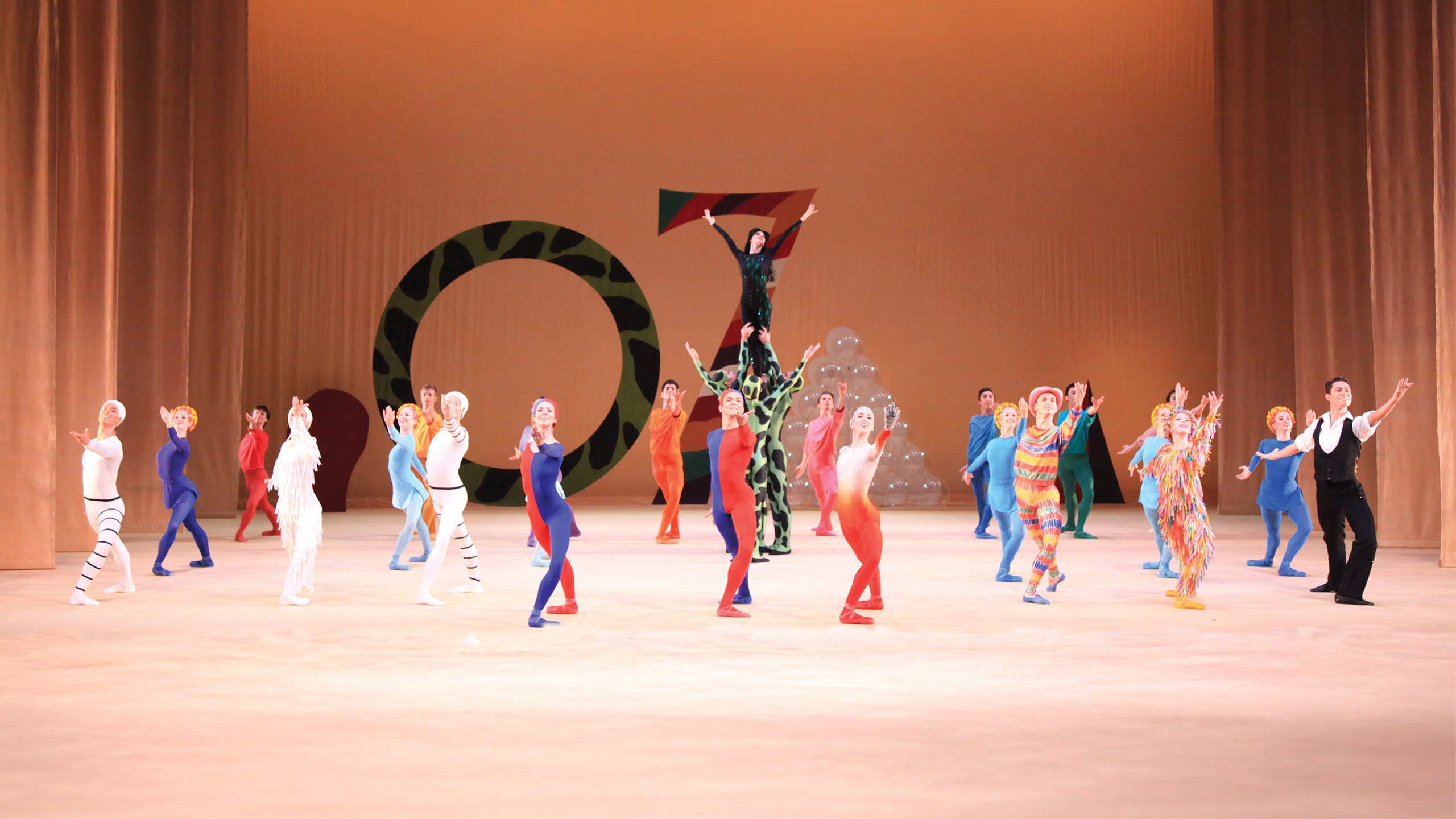Sir Frederick Ashton
Premiered January 9, 1968, by The Ballets Russes
The Sarasota Ballet Performing Sir Frederick Ashton’s Jazz Calendar | Photo by Frank Atura
The Sarasota Ballet Performing Sir Frederick Ashton’s Jazz Calendar | Photo by Foteini Christofilopoulou
The Sarasota Ballet Performing Sir Frederick Ashton’s Jazz Calendar | Photo by Frank Atura
Jazz Calendar
Asked to create a new ballet for a hastily-produced program to replace a canceled opera production of Aîda, Sir Frederick Ashton decided to base Jazz Calendar on an old English nursery rhyme, “Monday’s Child,” first published in 1838, but dating back to the 16th Century.
Impressed by designs for The Prodigal Son exhibited in Paris, Ashton invited Derek Jarman (later a leading British filmmaker) to produce jazzy décor, including perspex bubbles and sleek, brightlycolored unitards with skull-caps and bubble-wigs, turning the dancers, according to one critic, into “moving liquorice all-sorts.”
When Ashton approached Sir Richard Rodney Bennett about setting his First Symphony, the composer proposed instead a jazz score, commissioned in 1962 by the BBC, using a variety of traditional jazz forms, including a fast jazz waltz (Thursday’s Child) and a 12-bar blues (Friday’s Child). Initial resistance from Covent Garden’s contract orchestral players was overcome. Scored for four saxophones, two trumpets, trombone, horn, bassoon, piano, drums and bass, Jazz Calendar was definitively recorded in 1971 by the London Jazz Ensemble, conducted by John Lanchbery.
The star cast included Merle Park, Anthony Dowell, Antoinette Sibley, Rudolf Nureyev and a young Wayne Sleep. In larky mood, tongue firmly in cheek, Ashton crafted a series of jokes to illustrate the nursery rhyme. Monday is a solo “hymn to narcissism,” Tuesday a graceful trio in the style of his Monotones, while Wednesday is a sly take on Aurora’s rose adagio in The Sleeping Beauty. Thursday’s Alexander Grant and a female sextet characterized various forms of transport. Friday’s loving and giving was a blues for Sibley and Nureyev, Saturday’s male octet spoofed a men’s ballet class and Sunday mimicked the “stage revolve” finale of the popular TV variety show Sunday Night at the Palladium.
This popular ballet remained in The Royal Ballet repertoire until 1979, and was revived by Birmingham Royal Ballet in 1990.
Monday’s child is fair of face,
Tuesday’s child is full of grace,
Wednesday’s child is full of woe,
Thursday’s child has far to go.
Friday’s child is loving and giving,
Saturday’s child works hard for a living,
But the child who is born on the Sabbath Day
Is bonny and blithe and good and gay.
Sir Frederick Ashton was born in Ecuador in 1904 and determined to become a dancer after seeing Anna Pavlova dance in 1917 in Lima, Peru. Arriving in London, he studied with Léonide Massine and later with Dame Marie Rambert (who encouraged his first ventures in choreography) as well as dancing briefly in Ida Rubinstein’s company (1928-1929).
A Tragedy of Fashion (in which he danced alongside Marie Rambert) was followed by further choreographies (Capriol Suite, Façade) until in 1935 he accepted Dame Ninette de Valois’ invitation to join her Vic-Wells Ballet as Dancer and Choreographer, his principal loyalty remaining with what would become the Sadler’s Wells and ultimately The Royal Ballet. Besides his pre-war ballets at Sadler’s Wells (which demonstrated an increasing authority, with larger resources), Ashton choreographed for revues and musicals. His career would also embrace opera, film, and international commissions, creating ballets in New York, Monte Carlo, Paris, Copenhagen, and Milan. During the War, he served in the RAF (1941-1945) before creating Symphonic Variations for the Sadler’s Wells Ballet’s 1946 season in its new home at Covent Garden, affirming a new spirit of classicism and modernity in English postwar ballet.
During the next two decades, Ashton’s ballets, often created around the talents of particular dancers, included: Scènes de ballet, Cinderella (1948), in which Ashton and Robert Helpmann famously played the Ugly Sisters, Daphnis and Chloe (1951), Romeo and Juliet (1955), and Ondine (1958). He created La Fille mal gardée (1960) for Nadia Nerina and David Blair, The Two Pigeons (1961) for Lynn Seymour and Christopher Gable, Marguerite and Armand (1963) for Dame Margot Fonteyn and Rudolf Nureyev and The Dream (1964) for Dame Antoinette Sibley and Sir Anthony Dowell.
Appointed Associate Director of The Royal Ballet in 1952, Ashton succeeded Dame Ninette de Valois as Director from 1963 to 1970, and under his direction the company rose to new heights, while his choreographic career continued with Monotones II (1965), Jazz Calendar (1968), Enigma Variations (1968), A Month in the Country (1976) and the popular film success The Tales of Beatrix Potter (1971) in which he performed the role of Mrs. Tiggy-Winkle. He was knighted in 1962.
Named Founder Choreographer of The Royal Ballet, Sir Frederick Ashton died in 1988. His ballets, which remain in the international repertoire undiminished, show a remarkable versatility, a lyrical and highly sensitive musicality. He had an equal facility for recreating historical ballets and creating new works. If any single artist can be said to have formulated a native English classical ballet style and developed it over a lifetime, it is Sir Frederick Ashton.
Sir Richard Rodney Bennett was born in 1936 at Broadstairs in Kent. Coming from a musical family—his mother studied with Holst— he started composing when he was young and won a scholarship to the Royal Academy of Music in 1953, where he studied with Lennox Berkeley and Howard Ferguson. Earlier informal training from Elizabeth Lutyens, however, had instilled in him a curiosity for the avant garde, and so thanks to a scholarship from the French Government, he went to study with Boulez for two years, as well as enjoying visits to Darmstadt.
Having assimilated Boulez’s musical language, Bennett then developed what has been termed “a neo-Romantic serialism,” which, perhaps like that of Berg, was ideally suited to opera. Indeed, Bennett composed no fewer than three full-length operas in the 60’s: The Mines of Sulphur, A Penny for a Song and Victory. There is also the hugely popular, much performed children’s opera, All the King’s Men. In the 60’s and 70’s Bennett also composed works in a wide range of other genres—there are the largescale works for choir and orchestra, Epithalamion and Spells, as well as three symphonies and concertos and/or concertante pieces for almost every instrument. Sir Richard Rodney Bennett lived in New York City from 1979 until his death in December 2012.
Michael Derek Elworthy Jarman was born in Northwood, Middlesex, on 31 January 1942. He was the maverick radical of the British cinema during the late 1970’s, 80’s, and early 90’s. His highly idiosyncratic form of avantgarde art cinema managed to sustain itself due to his personal reputation as an auteur, as an enfant terrible and to his more or less public private life. Jarman was an artist of many dimensions: an author of autobiographical journals, a poet, a painter, a scriptwriter, a film director, a cinematographer and a set designer.
In 1968 he was asked by Sir Frederick Ashton to create the designs for Jazz Calendar. He continued throughout his career to make films and with the advent of Channel 4 funding in the mid-80’s, Jarman was able to develop his status as a major European auteur. Jarman’s fame, however, was mostly derived from his outspoken homosexuality, his never-ending public fight for gay rights and his subsequent personal struggle with AIDS; he died in London on 19 February 1994. Jarman is remembered as one of Britain’s most significant avant-garde filmmakers.
Monday’s child is fair of face,
Tuesday’s child is full of grace,
Wednesday’s child is full of woe,
Thursday’s child has far to go.
Friday’s child is loving and giving,
Saturday’s child works hard for a living,
But the child who is born on the Sabbath Day
Is bonny and blithe and good and gay.
Ethan Vail is originally from Indiana and has been the lighting designer for various art forms. His passion for lighting dance truly began in his college, Purdue University, and since then he has lit numerous ballets ranging from full length works like Johan Kobborg’s La Sylphide to one-act ballets including masterpieces by Ashton, George Balanchine, and Sir Kenneth MacMillan. He has also created original designs for choreographers Gemma Bond and Ricardo Graziano. Ethan’s work has also been seen in various theatres around the country including Westcoast Black Theatre Troupe, Urbanite Theatre, and Asolo Repertory Theatre. Highlights of his career thus far include winning the 2013 U.S. Institute for Theatre Technology’s Young Designers, Managers & Technicians Award; and lighting The Sarasota Ballet’s 2024 performances at The Royal Opera House in London.


